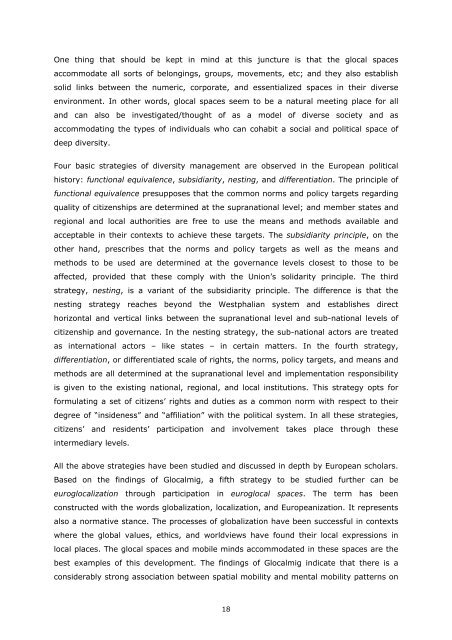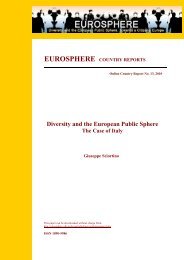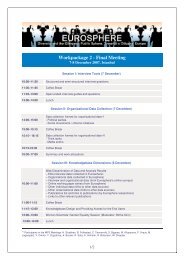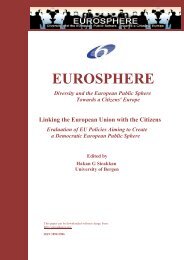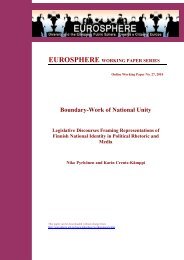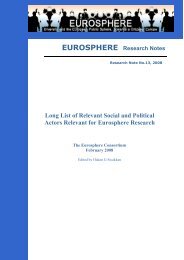Migrants, Minorities, Belongings and Citizenship. Glocalization and ...
Migrants, Minorities, Belongings and Citizenship. Glocalization and ...
Migrants, Minorities, Belongings and Citizenship. Glocalization and ...
You also want an ePaper? Increase the reach of your titles
YUMPU automatically turns print PDFs into web optimized ePapers that Google loves.
One thing that should be kept in mind at this juncture is that the glocal spaces<br />
accommodate all sorts of belongings, groups, movements, etc; <strong>and</strong> they also establish<br />
solid links between the numeric, corporate, <strong>and</strong> essentialized spaces in their diverse<br />
environment. In other words, glocal spaces seem to be a natural meeting place for all<br />
<strong>and</strong> can also be investigated/thought of as a model of diverse society <strong>and</strong> as<br />
accommodating the types of individuals who can cohabit a social <strong>and</strong> political space of<br />
deep diversity.<br />
Four basic strategies of diversity management are observed in the European political<br />
history: functional equivalence, subsidiarity, nesting, <strong>and</strong> differentiation. The principle of<br />
functional equivalence presupposes that the common norms <strong>and</strong> policy targets regarding<br />
quality of citizenships are determined at the supranational level; <strong>and</strong> member states <strong>and</strong><br />
regional <strong>and</strong> local authorities are free to use the means <strong>and</strong> methods available <strong>and</strong><br />
acceptable in their contexts to achieve these targets. The subsidiarity principle, on the<br />
other h<strong>and</strong>, prescribes that the norms <strong>and</strong> policy targets as well as the means <strong>and</strong><br />
methods to be used are determined at the governance levels closest to those to be<br />
affected, provided that these comply with the Union’s solidarity principle. The third<br />
strategy, nesting, is a variant of the subsidiarity principle. The difference is that the<br />
nesting strategy reaches beyond the Westphalian system <strong>and</strong> establishes direct<br />
horizontal <strong>and</strong> vertical links between the supranational level <strong>and</strong> sub-national levels of<br />
citizenship <strong>and</strong> governance. In the nesting strategy, the sub-national actors are treated<br />
as international actors – like states – in certain matters. In the fourth strategy,<br />
differentiation, or differentiated scale of rights, the norms, policy targets, <strong>and</strong> means <strong>and</strong><br />
methods are all determined at the supranational level <strong>and</strong> implementation responsibility<br />
is given to the existing national, regional, <strong>and</strong> local institutions. This strategy opts for<br />
formulating a set of citizens’ rights <strong>and</strong> duties as a common norm with respect to their<br />
degree of “insideness” <strong>and</strong> “affiliation” with the political system. In all these strategies,<br />
citizens’ <strong>and</strong> residents’ participation <strong>and</strong> involvement takes place through these<br />
intermediary levels.<br />
All the above strategies have been studied <strong>and</strong> discussed in depth by European scholars.<br />
Based on the findings of Glocalmig, a fifth strategy to be studied further can be<br />
euroglocalization through participation in euroglocal spaces. The term has been<br />
constructed with the words globalization, localization, <strong>and</strong> Europeanization. It represents<br />
also a normative stance. The processes of globalization have been successful in contexts<br />
where the global values, ethics, <strong>and</strong> worldviews have found their local expressions in<br />
local places. The glocal spaces <strong>and</strong> mobile minds accommodated in these spaces are the<br />
best examples of this development. The findings of Glocalmig indicate that there is a<br />
considerably strong association between spatial mobility <strong>and</strong> mental mobility patterns on<br />
18


